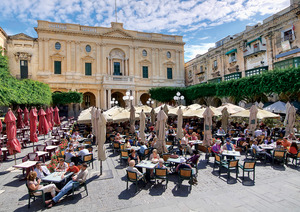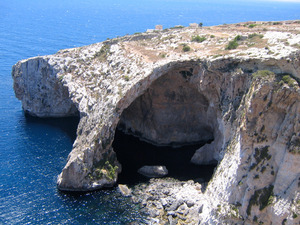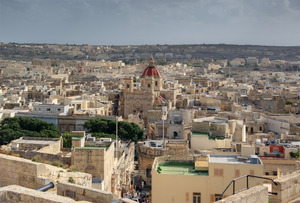 Malta is a fabulous Mediterranean destination especially if you dislike the hassle of foreign languages. Everyone speaks good to perfect English yet Malta retains all the charm of the Mediterranean.
Malta is a fabulous Mediterranean destination especially if you dislike the hassle of foreign languages. Everyone speaks good to perfect English yet Malta retains all the charm of the Mediterranean.
The universality of English is down to Malta being part of the British Empire from 1814 until 1964 but strangely it was not one of the Empire’s conquests. In the Napoleonic era Malta was between a rock and a hard place – at risk of being invaded by the French and the Russians. It opted for the protection of the British Empire and subsequently played a crucial role in defeating Rommel’s Afrika Korps in North Africa during WWII.
It’s a tiny place, significantly smaller than the Isle of Wight, with a familiar yet foreign ambience. They have the highest density of catholic priests outside the Vatican City, produce and explode more fireworks per head than anywhere else on earth and eat an unbelievable number of rabbits.
Of course, they drive on left and something I love is how its kept some of the classic images from my childhood – old red telephone boxes, red post boxes and blue lights outside police stations. Sadly EU bureaucrats have forced the withdrawal of the famous orange vintage Leyland and Bedford buses.
 The World Heritage listed capital of Valletta is Europe’s first planned city, laid out in a grid system of streets and alleyways. The Knights of St John built it on a peninsula as a defence against the Turks during the sixteenth century.
The World Heritage listed capital of Valletta is Europe’s first planned city, laid out in a grid system of streets and alleyways. The Knights of St John built it on a peninsula as a defence against the Turks during the sixteenth century.
The Upper Barrakka Gardens provide a must-see harbour and city view and the Grand Master’s palace and armoury is a must. Don’t be put off by the plain exterior of St John cathedral; it belies a fabulous Baroque interior and a famous painting by Caravaggio.
Valletta’s real charm is its ambience, so it’s important to sit in an outdoor cafe and soak up the palpable sense of history rather than just rushing around the sites –the perfect excuse for loafing.
But all this is just recent history; Malta’s prehistoric megalithic temples are older than Stonehenge or the Pyramids. It’s a dream destination for historians and reads like a textbook of western civilisation, probably with more human history packed into its122 sq miles than anywhere else on earth.
 There are 23 prehistoric sites dating back 6,000 years including the impressive megalithic temples of Taraxien and Hagar Qim but the subterranean hypogeum of Hal Saflieni is perhaps the most breathtaking. It is the only known underground pre-historic temple.
There are 23 prehistoric sites dating back 6,000 years including the impressive megalithic temples of Taraxien and Hagar Qim but the subterranean hypogeum of Hal Saflieni is perhaps the most breathtaking. It is the only known underground pre-historic temple.
Not much is known about these ancient temple builders or their mysterious parallel ‘cart tracts’ gouged into the limestone. They’ve been likened to a complex railway junction (Clapham Junction) because they criss-cross the landscape and some even disappear off the edge of the cliff – creating an endless source of myths and legends.
Homer’s Odyssey tells of Ulysses being shipwrecked on the nearby island of Gozo where Calypso captivated him on his journey back from Troy to Ithaca in Greece.
Then there are the Phoenicians from the Biblical cities of Tyre and Sidon who traded and settled Malta until ousted by the Roman’s. St Paul was also shipwrecked on Malta en-route to Rome and his indelible legacy of Christianity is still evident in the islands 360 churches.
 The marks of Norman and Arab conflicts are everywhere on the island, culminating with the spectacular city of Valletta built by the Knights of St John in 1566. Malta’s history rolls on involving the Spanish Empire; Napoleon predictably turned up and of course the British.
The marks of Norman and Arab conflicts are everywhere on the island, culminating with the spectacular city of Valletta built by the Knights of St John in 1566. Malta’s history rolls on involving the Spanish Empire; Napoleon predictably turned up and of course the British.
But its not history that makes Malta one of the UK’s favourite holiday destinations – it’s the glorious weather, the friendly people, the Mediterranean lifestyle and the convenience of English speakers.
When Malta’s history, shopping and nightlife pall the 20-minute ferry across to Gozo is like moving to another country. It is Malta’s exclusive hideaway island with a pastoral ambience compared to Malta’s brasher tourist developments. Everything runs at a slower pace on Gozo.
The islands capital of Rabat was renamed Victoria in 1897 to commemorate the Queen’s Diamond jubilee but its still the beautiful quaint town of alleyways, cafes and little shops it always was. The imposing walled citadel sheltered people from the marauding corsairs who plagued island communities throughout the Mediterranean.
 Gozo has its share of prehistoric monuments such as the Ggantija temple – supposedly built by giantesses and more mysterious ‘cart ruts’.
Gozo has its share of prehistoric monuments such as the Ggantija temple – supposedly built by giantesses and more mysterious ‘cart ruts’.
The impressive Romanesque Basilica of Ta Pinu dominates the Gozitan skyline and has become a local shrine with a Lourdes-like status for miracle cures. Inside the walls are adorned with artificial limbs and other relics left by grateful pilgrims.
So don’t bother with a history book in Malta, just stroll around and let it all seep in, and between momentous historical events you’ll be able to find a perfect pasta and a decent pint of beer.
- Things to do and attractions in Malta
- For more information about Rail travel, read Peter Lynch’s Blog











